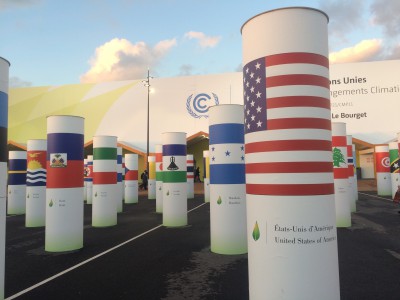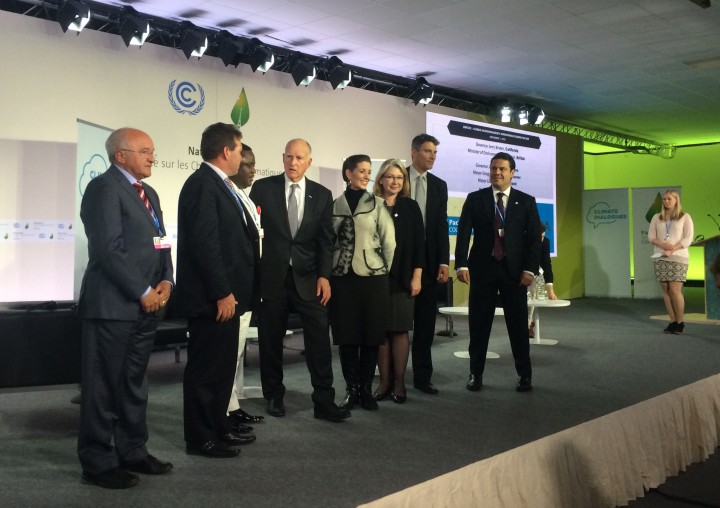PARIS – It’s not surprising that there was no mention of North Carolina at an international climate conference attended by 40,000 people from every corner of the world.
But the landmark agreement reached two weeks ago at the 21st United Nations Framework Convention on Climate Change, or COP21, presents an opportunity for North Carolina to make the most of an inevitable push toward more renewable energy and less fossil fuels.
Supporter Spotlight

Rows of public art pillars at the conference entrance, each decorated with a different national flag, effectively illustrated the sense of unity in the global mission to stem global warming. Inside the cavernous center, people hurried in and out of huge buildings on either side of a corridor decorated with bright plastic animal sculptures and rock-filled cage planters. At the far end stood an art deco version of the Eiffel Tower, which on closer look were skillfully stacked rust-colored metal chairs.
The accord signed by 195 nations is intended to cut greenhouse gas emissions that scientists say are dangerously warming the planet. The long-term goal is to keep temperatures from rising above 2 degrees Celcius, or 3.6 degrees Fahrenheit, when the most destructive consequences would happen.
Although critics of the climate pact warn of negative economic effects, proponents say that it’s more likely to create stronger carbon markets, in which North Carolina currently does not participate.
“The unsung hero of the agreement,” wrote Nat Keohane, an economist with the Environmental Defense Fund, “is a set of provisions that encourages the use of markets to drive up investment in clean energy and drive down pollution.”
According to Keohane, EDF’s vice president for international climate, there are already functioning emissions-trading systems in more than 50 locations that are home to a total of nearly 1 billion people.
Supporter Spotlight

“The role of markets may not be in this week’s headlines,” he continued, “but a decade from now, it will be one of the enduring legacies of Paris.”
Although he was not speaking for North Carolina, Brian Murray, director for economic analysis at Duke University’s Nicholas Institute for Environmental Policy Solutions, sees reasons to be optimistic about the state.
Murray, one of the world’s experts on carbon trading, had attended the Paris conference and participated in a panel discussion on cap-and-trade economics. He was accompanied in Paris by a group of Duke graduate students who observed the negotiations.
“North Carolina has cut its coal use down in the last decade, thanks to the Clean Smokestacks rule,” Murray said during an interview at the conference.
Murray said that the state’s renewable energy portfolio has encouraged the state’s growth in green power.

Along with natural gas, he said, solar and wind energy are replacing coal power in the state, and across the U.S. About a decade ago, coal produced about 50 percent of the power in the country. Now, Murray said, coal accounts for less than 40 percent of U.S. energy production, and there are no plans anywhere to build new coal units. The same percentages apply in North Carolina, he said.
North Carolina is one of 24 states challenging the Environmental Protection Agency’s Clean Power Plan that calls for reductions in carbon emissions from power plants.
North Carolina is in the process of developing a state plan to meet the Clean Power Plan requirement, Murray said. Meanwhile, he said, he has been involved in an “information-sharing process” among Southeast states where they support and learn from each other in developing clean power.
But on Friday, the N.C. Department of Environmental Quality doubled down on its “all of the above” energy policy in a statement that lauded oil and gas projects and the state joining in the lawsuit against the Clean Power Plan.
Republicans in general are not supportive of President Obama’s pledge to cut greenhouse gas emissions to 28 percent below 2005 levels over the next 10 years, and 80 percent by 2050.
As it turns out, the only naysayers in Paris were at the conservative think tank Heartland Institute’s “Day of Examining the Data” conference held on Dec. 7 and featuring a video keynote address from Sen.. Jim Inhofe, R-Okla., and presentations by climate change skeptics from the U.S., Europe and Canada. They contend that doomsday climate forecasts are exaggerated and reduction of fossil fuel usage would hurt economic growth.
But the Heartland event was largely ignored, with several media outlets reporting little more than two dozen attendees.

With or without the backing of state and federal policies, however, businesses can successfully participate in the carbon market, said Hunter Parks, president of Green Assets in Wilmington.
Parks, who also attended the Paris conference, said that his farm, Mattamuskeet Ventures in Hyde County, became the first Avoided Conversion Carbon Offset Forestry project in the country. That means by not converting a percentage of his forested land to farmland, his company was able to get credits for keeping the carbon in trees instead of the atmosphere.
The company developed a similar carbon offset project on Lukens Island in Carteret County.
Park, who has worked with the N.C. Coastal Federation on stormwater projects, said he has obtained carbon credits from the California carbon market, which generated more than $1 billion in revenue in 2013. California passed the Global Warming Solutions Act in 2006 that called for a reduction in its greenhouse gases to 1990 levels by 2020, with one-third of energy coming from renewable sources. A byproduct of the law was creation of a cap-and-trade program.
A project anywhere in the U.S. can create carbon offsets for that program, he said.
“So those are credits that can be generated and sold.”
One potential benefactor in North Carolina could be hog farms, which create enormous quantities of methane-producing hog waste. Conversion of the waste is costly, he said, but carbon offsets, along with some private incentives, could make it affordable.
“What’s going on here,” Parks said in an interview in Paris, “if it creates momentum for carbon policy throughout the U.S. and the rest of the world, opportunities for hog farms in North Carolina could generate carbon credits and reduce CO2.”
“It’s not the cheapest way to manage the waste,” he added, “so a stronger market would help with that.”
Parks and Murray both noted the richness of the networking opportunities at the conference, where every sector having to do with anything related to carbon or emissions negotiations was there.
Relatively few of the attendees were dealing directly with the global negotiations, Murray said. “Even though we’re at an international negotiating conference, people come here and talk about domestic policies that are going on,” he said. “So this is a place where you essentially exchange information.”
The overriding tone of the conference was that the fossil fuel economy is in the rear-view mirror. Between exhibits on ocean environments, agriculture, social justice, animal welfare, fisheries, renewable energies, micro-grids and innovative clean technologies, the message was optimistic that the world, working toward the same goal, could save the future from the worst effects of a warming planet.

A panel of representatives from the Pacific Coast Collaborative, which includes members from the U.S. and Canadian West Coast, encouraged other local and state governments to take advantage of robust carbon markets.
“The science tells us the way you drive down those emissions is continually driving up that carbon price,” said Mary Polak, minister of environment for British Columbia.
Their GDP went up much faster than anywhere else in Canada, she said. Emissions went down; consumption of fuel went down.
“We’ve seen the positive impacts,” Polak said. “We know that it works.”
In a typical California jab to the East Coast, California Gov. Jerry Brown boasted that West Coasters “intrinsically understand” that clean energy is “one of the greatest job-creating opportunities.”
“We’re open for business on the Pacific coast,” Brown said. “We’re rocking and we’re leading the charge. On the West Coast, we live our innovation.”
Although the Regional Greenhouse Gas Initiative, a cooperative of nine Northeastern states – New Jersey pulled out in 2011 – and eastern Canada, works to reduce emissions from the electric power sector, it has limited scope and has no members from the Southeastern states.
“It’s true, there are still a lot of people, particularly in the chamber, who pooh-poohs climate change,” Brown said, despite his state’s twin plagues of drought and fire. “So it’s a real thing and it’s unfortunate that some people got it in their head that climate change is a left idea. All that connotes government regulation – the ideology is climate change is bad.”
Brown said a solid agreement from Paris may encourage more economic development from green energy policies “and I think that idea will get through to these knuckleheads.”









